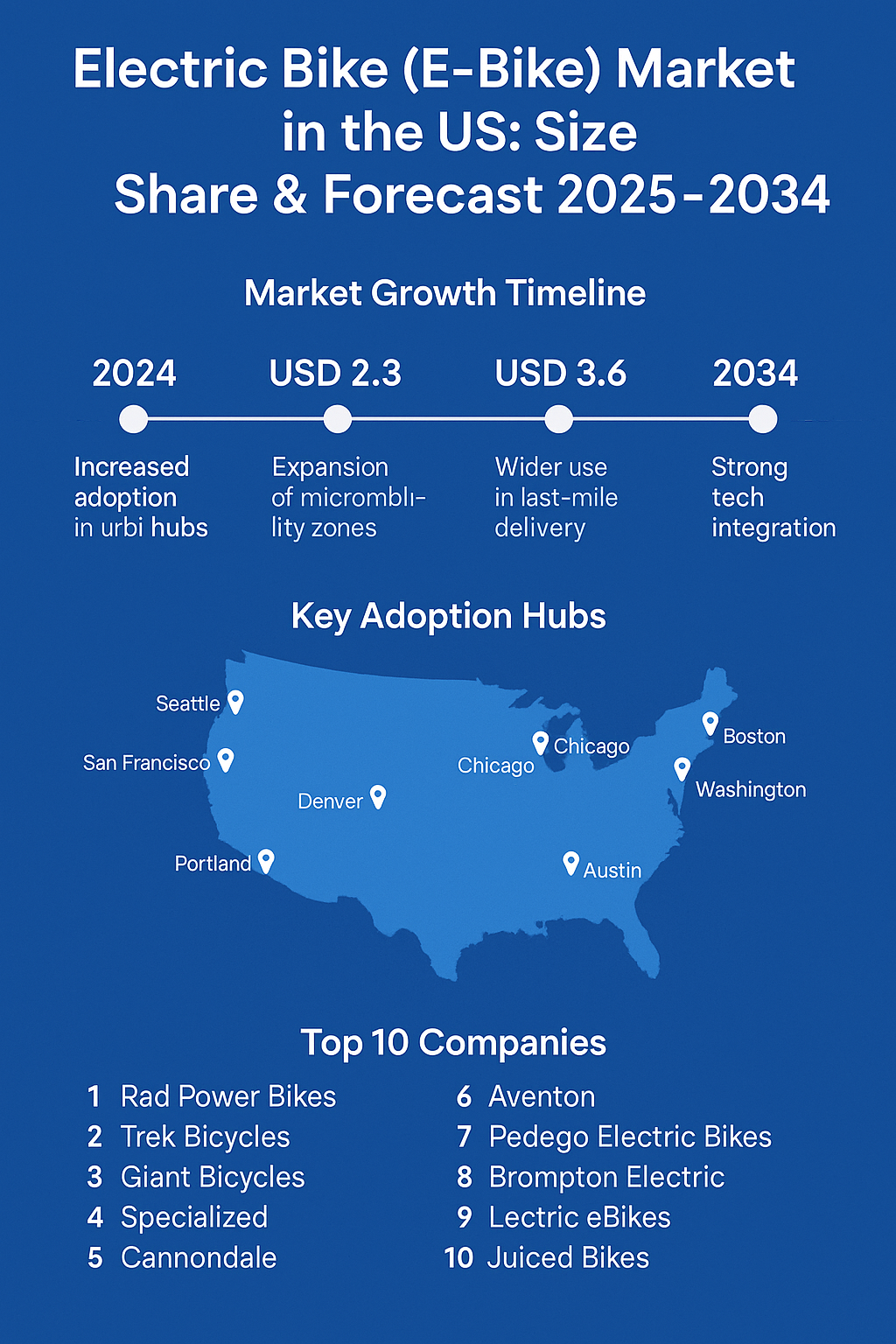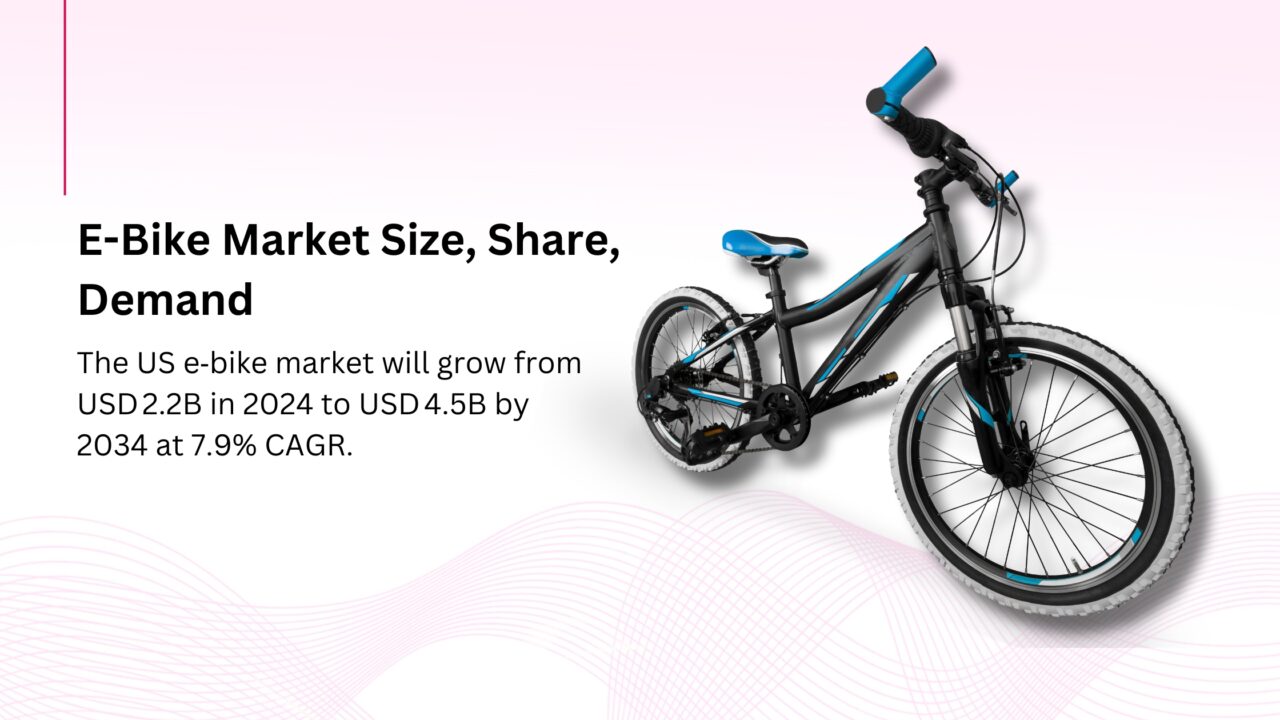The US e‑bike market is experiencing unprecedented growth, valued at USD 2.2 billion in 2024 and projected to reach USD 4.5 billion by 2034 with a CAGR of 7.9%. As cities expand bike‑friendly infrastructure and governments roll out incentive programs, electric bikes are becoming an integral part of urban mobility. From bustling hubs like New York and San Francisco to emerging markets in Austin and Denver, adoption is accelerating thanks to sustainability goals, improved battery technology, and shifting consumer lifestyles.
Interestingly, this transformation mirrors the AI‑driven shift in logistics we explored in our Top AI Logistics Use Cases blog, where technology is reimagining entire industries — and e‑bikes are at the forefront of change in mobility.
1. Market Growth and Size
The U.S. e‑bike market’s trajectory reflects a strong combination of policy support, consumer adoption, and infrastructure investment.
| Year | Market Size (USD Billion) | Growth Driver Highlights |
|---|---|---|
| 2024 | 2.2 | Increased adoption in major urban hubs, early government rebates |
| 2025 | 2.3 | Expansion of micromobility zones, more city‑level e‑bike sharing |
| 2030 | 3.6 | Wider cargo e‑bike use for last‑mile delivery |
| 2034 | 4.5 | Strong tech integration, advanced battery technology |
Key Adoption Hubs in the US
-
New York City, NY – Aggressive bike lane expansion, city‑subsidised cargo e‑bike programs for delivery workers, and parking solutions for high‑traffic areas.
-
San Francisco, CA – Integration of e‑bikes into public transit fare systems, commuter‑friendly routes with charging stations along key corridors.
-
Portland, OR – One of the most bike‑friendly cities in the US with a strong cycling culture, city‑wide safety campaigns, and rebates for residents.
-
Denver, CO – Highly successful statewide e‑bike rebate program, making Colorado a leader in e‑bike affordability and adoption.
-
Austin, TX – Infrastructure for large‑scale cargo bike usage, favourable weather, and a growing tech workforce embracing sustainable commuting.
-
Seattle, WA – Integration with mobility‑as‑a‑service (MaaS) platforms and partnerships with local employers to promote e‑bike commuting.
-
Chicago, IL – Expanded Divvy bike‑sharing fleet with electric models, increased cycling infrastructure along major commuter corridors.
-
Washington, DC – Federal city encouraging micromobility for short government commutes, backed by policy incentives.

2. Key Drivers of Growth
-
Urbanisation & Sustainable Mobility – Cities are redesigning streets for micromobility, prioritising bikes over cars.
-
Government Incentives – Colorado’s $1,700 rebate, California’s Clean Vehicle Incentive, and other state programs.
-
Health & Fitness Trends – E‑bikes serve as a hybrid between exercise and convenience.
-
Infrastructure Development – Charging networks, bike‑sharing, and cargo‑bike‑friendly routes are expanding rapidly.
3. Market Segmentation
By Battery Type
| Battery Type | Market Share (2024) | Revenue (USD Billion) | Growth Factors |
|---|---|---|---|
| Lithium‑ion | ~48% | ~1.0 | Lightweight, fast charging, long lifespan |
| Lead‑acid | ~20% | 0.44 | Lower cost, entry‑level models |
| Others | ~32% | 0.70 | Emerging chemistries, niche uses |
By Class
| Class | Description | 2024 Share | CAGR (2024–2034) |
|---|---|---|---|
| Class 1 | Pedal‑assist up to 20 mph | 43% | ~8% |
| Class 2 | Throttle‑assist | 32% | ~6.5% |
| Class 3 | Pedal‑assist up to 28 mph | 25% | ~7.5% |
By Application
| Application | Market Role |
|---|---|
| Trekking E‑Bikes | Leisure and adventure cycling |
| Cargo E‑Bikes | Last‑mile delivery, logistics |
| Urban/City E‑Bikes | Short urban commutes, errands |
4. Competitive Landscape – Top 10 US E‑Bike Companies
| Company | Specialisation |
|---|---|
| Rad Power Bikes | Largest US brand, cargo and commuter e‑bikes |
| Trek Bicycles | Premium performance, commuter, and recreational |
| Giant Bicycles | High‑performance road and mountain e‑bikes |
| Specialized | Advanced battery tech, high‑end builds |
| Cannondale | Performance hybrids and urban models |
| Aventon | Affordable, stylish commuter e‑bikes |
| Pedego Electric Bikes | Comfort‑focused leisure e‑bikes |
| Brompton Electric | Compact folding e‑bikes for city professionals |
| Lectric eBikes | Value‑driven folding and fat‑tire e‑bikes |
| Juiced Bikes | High‑power, long‑range urban and cargo bikes |
These brands are innovating with lightweight frames, extended battery ranges (up to 100 miles), and smart IoT connectivity for navigation, theft prevention, and performance tracking.
5. Challenges and Risks
-
Supply Chain Reliance – Over 90% of bicycles imported from Asia.
-
Safety Concerns – Regulatory tightening over high‑speed models.
-
Regulatory Complexity – Varying state laws on classification and licensing.
6. Future Outlook
| Trend | Impact by 2034 |
|---|---|
| Ride‑sharing integration | E‑bike fleets tied into public transport systems |
| Battery innovation | Solid‑state batteries reducing charging times by 50% |
| Sustainable manufacturing | Recycled materials becoming the industry standard |
| Smart features | AI‑driven diagnostics, GPS, anti‑theft systems |
Conclusion
The U.S. e‑bike market is set for a decade of strong growth, with sales expected to hit USD 4.5 billion by 2034. Manufacturers focusing on cargo solutions, urban mobility, and connected tech will be best positioned to capitalise. For cities, integrating e‑bikes into transport policy will not only reduce emissions but also enhance urban connectivity.

